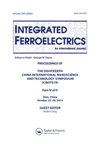烧成温度对固态燃烧法制备BNBKL陶瓷相形成、微观结构和电性能的影响
IF 0.7
4区 工程技术
Q4 ENGINEERING, ELECTRICAL & ELECTRONIC
引用次数: 0
摘要
摘要采用固态燃烧法制备了无铅0.85Bi0.5Na0.475Li0.025TiO3-0.11Bi0.5K0.5TiO3-0.04BaTiO3 (BNBKL)陶瓷。将BNBKL粉末和陶瓷分别在650 ~ 850℃下煅烧1 ~ 5 h和1100 ~ 1140℃下煅烧2 h。研究了烧成温度对BNBKL陶瓷相结构、微观结构和电性能的影响。在800℃煅烧3 h时,BNBKL粉末的x射线衍射图显示为纯钙钛矿相结构,不同温度下烧结的BNBKL陶瓷具有菱形(R)和四方(T)相共存的特点。晶粒呈多面体形状,生长无方向性。当烧结温度从1100℃升高到1140℃时,BNBKL陶瓷的平均晶粒尺寸从0.80µm增加到1.26µm。当烧结温度达到1120℃时,BNBKL陶瓷的密度随烧结温度的升高而增大,随后密度减小。烧结温度为1120℃时,密度为6.05 g/cm3,介电常数为5855。随着烧结温度的升高,BNBKL陶瓷的极化磁滞回线(P-E回路)饱和度降低,缩紧度增加,表现出更强的弛豫行为。关键词:bnbkl固态燃烧介质和铁电致谢感谢河南大学理学院物理系提供的支持设施。同时感谢Kyle V. Lopin博士助理教授对本文的编辑工作的帮助。披露声明作者未报告潜在的利益冲突。本文章由计算机程序翻译,如有差异,请以英文原文为准。
Firing Temperatures Effect on Phase Formation, Microstructure and Electrical Properties of BNBKL Ceramics Fabricated via the Solid-State Combustion Technique
AbstractLead-free 0.85Bi0.5Na0.475Li0.025TiO3-0.11Bi0.5K0.5TiO3-0.04BaTiO3 (BNBKL) ceramics were prepared by the solid-state combustion technique. The BNBKL powders and ceramics were calcined and sintered between 650 to 850 °C for 1–5 h and 1100 to 1140 °C for 2 h, respectively. The effect of firing temperatures on the phase structure, microstructure, and electrical properties of BNBKL ceramics was investigated. X-ray diffraction patterns of BNBKL powders showed a pure perovskite phase structure at a calcination temperature of 800 °C for 3 h. The BNBKL ceramics sintered at different temperatures possessed coexisting rhombohedral (R) and tetragonal (T) phases. The ceramic grains showed a polyhedral shape with directionless growth. The average grain size of the BNBKL ceramics increased from 0.80 to 1.26 µm when the sintering temperature increased from 1100 to 1140 °C. The density of the BNBKL ceramics increased as the sintering temperature increased up to 1120 °C, after that it decreased. The highest density (6.05 g/cm3) and dielectric constant (5855), were obtained at the sintering temperature of 1120 °C. As the sintering temperature increased, the polarization hysteresis loops (P-E loops) of the BNBKL ceramics exhibited less saturation and were more pinched, indicating more relaxor behavior.Keywords: BNBKLsolid-state combustiondielectric and ferroelectric AcknowledgmentsThe authors thank the Department of Physics, Faculty of Science, Naresuan University for their supporting facilities. Thanks are also given to Asst. Prof. Dr. Kyle V. Lopin for his help in editing the manuscript.Disclosure StatementNo potential conflict of interest was reported by the author(s).
求助全文
通过发布文献求助,成功后即可免费获取论文全文。
去求助
来源期刊

Integrated Ferroelectrics
工程技术-工程:电子与电气
CiteScore
1.40
自引率
0.00%
发文量
179
审稿时长
3 months
期刊介绍:
Integrated Ferroelectrics provides an international, interdisciplinary forum for electronic engineers and physicists as well as process and systems engineers, ceramicists, and chemists who are involved in research, design, development, manufacturing and utilization of integrated ferroelectric devices. Such devices unite ferroelectric films and semiconductor integrated circuit chips. The result is a new family of electronic devices, which combine the unique nonvolatile memory, pyroelectric, piezoelectric, photorefractive, radiation-hard, acoustic and/or dielectric properties of ferroelectric materials with the dynamic memory, logic and/or amplification properties and miniaturization and low-cost advantages of semiconductor i.c. technology.
 求助内容:
求助内容: 应助结果提醒方式:
应助结果提醒方式:


